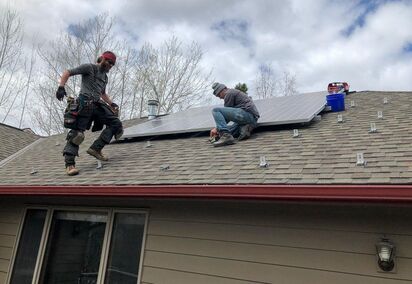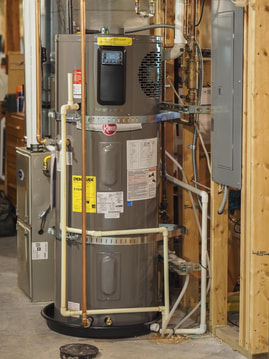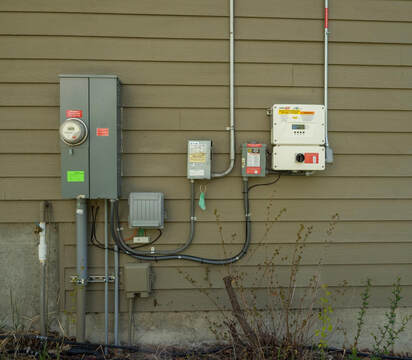|
Project Type: Residential Retrofit System Type: Hybrid Electric Hot Water Heater, Induction Stove, Electrical Service Upgrade, Solar PV Array Contractor(s): SBS Solar, Plumb-Tech Plumbing and Heating (Hybrid Electric Hot Water Heater), Pete's Electric (Upgrade electrical service from 100 to 200 amps, install circuit for new hot water heater), Fred's Appliances (Frigidaire induction range)
Besides the solar upgrade, their recent project included upgrading the home’s electrical service from 100 to 200 amps, swapping a natural gas hot water heater that was due for replacement with a hybrid electric one (a Rheem 50-gallon ProTerra hybrid electric hot water heater, recommended by the contractor), and replacing an electric range with an induction range. Today, the existing natural gas furnace is the only appliance that’s not electric. With the help and prompting from friends at Climate Smart, and an array of contractors, (more than half a dozen!), they completed their project on time and on budget. Bert commented that the biggest barrier “was simply getting up the gumption to face all of the tasks required to complete the project we envisioned.” This isn’t the first time we’ve heard from homeowners about the sometimes overwhelming and complex web of decision-making that comes with retrofitting and upgrading to electric appliances. If you’re interested in upgrading to electric systems and aren’t sure where to start, we’ve outlined a few key considerations on our "resources for homeowners" page. In terms of financing, Bert and Kristi were comfortable with the fact that the new solar panels would pay for themselves over the next decade or two, assuming that "net metering" remains in place. They did have to both upgrade their electrical system and seal the natural gas supply before converting their natural gas hot water heater to electric, which added cost on top of the upfront cost of the new water heater ($1,500). All said and done, the new hot water heater with its additional installation costs makes for a long, if not unresolvable, payback period however; however, they have not paid for electricity since their solar installation was upgraded this spring! They had originally planned to complete the project using their savings, but ultimately decided to take advantage of the MT Dept. of Environmental Quality’s Alternative Energy Revolving Loan Program. They also received federal tax credits for the 2021 tax year.
As for the induction range, Bert says they chose a Frigidaire model because “it was thousands of dollars cheaper than competing brands and because one became available on short notice.” Induction ranges typically have to be ordered, and they can take months to arrive. Choosing a location for the new hot water heater was relatively straightforward: “It went right where the natural gas water heater had gone in our basement. Our basement is entirely open, is unheated, and has no one living in it. There’s plenty of room to draw air into the water heater’s heat pump and there’s no one nearby to be disturbed when the fan goes on.” Their basement temperature maintains a steady temperature between 50-55 degrees which helps performance in the winter. And for Homeowners looking to do something similar? “Decide what you’re trying to accomplish, the best means to do so, and move ahead. Remember, the changes you make to your home aren’t just for you. They will probably be in place for the lifetime of your home. The environment will benefit for generations, even though your personal benefits may just be for a few years until you sell your home.” - Bert Lindler and Kristi DuBois
0 Comments
|
Electrify Missoula is a collaboration between Missoula County, Climate Smart Missoula and the City of Missoula.
This website is intended for informational purposes only. Be sure to consult a professional before making your plan for electrification.
This website is created and updated by Climate Smart Missoula.
Learn more about all of our local climate efforts at
missoulaclimate.org
Learn more about all of our local climate efforts at
missoulaclimate.org
Proudly powered by Weebly




 RSS Feed
RSS Feed


